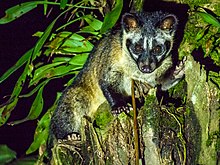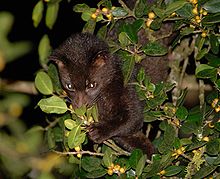Paradoxurus
| Paradoxurus[1] | |
|---|---|

| |
| Asian palm civet (Paradoxurus hermaphroditus) | |
| Scientific classification | |
| Domain: | Eukaryota |
| Kingdom: | Animalia |
| Phylum: | Chordata |
| Class: | Mammalia |
| Order: | Carnivora |
| Suborder: | Feliformia |
| Family: | Viverridae |
| Subfamily: | Paradoxurinae |
| Genus: | Paradoxurus Cuvier, 1822 |
| Type species | |
| Species | |
|
see table | |

| |
| Paradoxurus ranges | |
Paradoxurus is a genus of three palm civets within the viverrid family that was denominated and first described by Frédéric Cuvier in 1822.[3] The Paradoxurus species have a broad head, a narrow muzzle with a large rhinarium that is deeply sulcate in the middle. Their large ears are rounded at the tip. The tail is nearly as long as the head and body.[4]
The three species are the Asian palm civet, the Golden palm civet, and the Brown palm civet.[1]
Characteristics
Paradoxurus species have a broad head, a narrow muzzle with a large rhinarium that is deeply sulcate in the middle. Their large ears are rounded at the tip, the interior ridges and
Taxonomy
As of 2005, this genus was defined as comprising three species native to Southeast Asia:[1]
| Name | Image | Distribution |
|---|---|---|
| Asian palm civet, P. hermaphroditus (Pallas, 1777)[5] |  |

|
| Golden palm civet, P. zeylonensis Pallas, 1778[6] |  |
Sri Lanka |
| Brown palm civet, P. jerdoni Blanford, 1885[7] |  |
Western Ghats, India |
In 2009, it was proposed to also include the
References
- ^ OCLC 62265494.
- OCLC 62265494.
- ^ Cuvier, F. (1822). "Du genre Paradoxure et de deux espèces nouvelles qui s'y rapportent". Mémoires du Muséum d'Histoire Naturelle Paris. 9: 41–48.
- ^ a b Pocock, R. I. (1939). "Paradoxurus". The Fauna of British India, including Ceylon and Burma. Vol. 1. Mammalia. London: Taylor and Francis. pp. 379–415.
- ^ Pallas, P. S. (1778). "Das Zwitterstinkthier". In Schreber, J. C. D. (ed.). Die Säugethiere in Abbildungen nach der Natur, mit Beschreibungen. Erlangen: Wolfgang Walther. p. 426.
- ^ Pallas, P. S. (1778). "Der Boshond". In Schreber, J. C. D. (ed.). Die Säugethiere in Abbildungen nach der Natur, mit Beschreibungen. Erlangen: Wolfgang Walther. p. 451.
- .
- .
- ^ .
- ^ Duckworth, J.W.; Timmins, R.J.; Choudhury, A.; Chutipong, W.; Willcox, D.H.A.; Mudappa, D.; Rahman, H.; Widmann, P.; Wilting, A. & Xu, W. (2016). "Paradoxurus hermaphroditus". IUCN Red List of Threatened Species. 2016: e.T41693A45217835.
External links
![]() Media related to Paradoxurus at Wikimedia Commons
Media related to Paradoxurus at Wikimedia Commons
- "Paradoxurus". ASM Mammal Diversity Database. American Society of Mammalogists. Retrieved 3 June 2019.
